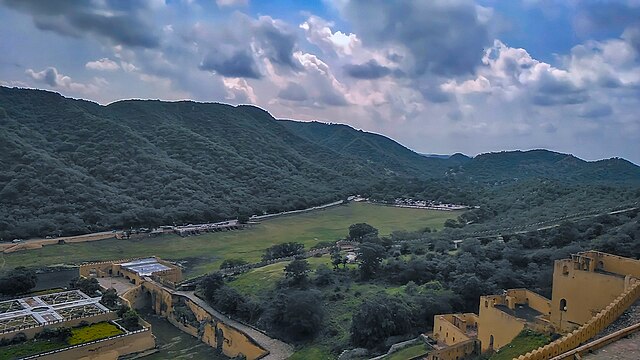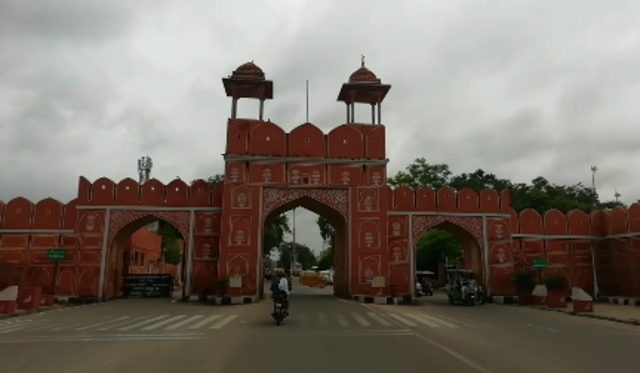Jaipur, the vibrant capital of Rajasthan, is a city that dazzles with its palaces, forts, and rich cultural heritage. But let’s be real—its weather can be just as dramatic! From scorching summer days that feel like you’re walking into an oven to chilly winter nights that make you crave a warm quilt, Jaipur’s temperature swings keep everyone on their toes. Whether you’re a local, a tourist planning a visit, or just curious about the Pink City’s climate, understanding Jaipur’s temperature patterns is key to making the most of your time here. So, what’s the deal with Jaipur’s weather? Let’s dive into the details and unpack everything you need to know about the city’s temperature trends, seasonal shifts, and how to stay comfortable no matter the season.
Why Jaipur’s Temperature Matters
Jaipur’s climate isn’t just small talk—it’s a big deal. The city’s temperature shapes daily life, from what you wear to how you plan your day. For tourists, it can make or break a trip. Imagine exploring Amber Fort under a blazing 45°C sun or strolling through the City Palace during a chilly 10°C evening. Knowing what to expect helps you pack smart, stay safe, and enjoy the city’s charm. For locals, it’s about adapting to extreme heatwaves, sudden rains, or foggy winter mornings. So, why does Jaipur’s temperature fluctuate so much, and how can you prepare? Let’s break it down.
Jaipur’s Geographical Influence on Temperature
Nestled in the semi-arid region of Rajasthan, Jaipur sits at about 438 meters above sea level, surrounded by the Aravalli hills. This location is like a double-edged sword: it gives the city its stunning backdrop but also contributes to its extreme weather. The hills block some monsoon winds, making rainfall unpredictable, while the arid landscape amplifies heat during summer. Think of Jaipur as a city that’s constantly negotiating with the sun and the clouds, resulting in a climate that’s as colorful as its markets.
Jaipur’s Climate: A Seasonal Breakdown

Jaipur’s weather is a rollercoaster ride through three main seasons: summer, monsoon, and winter. Each brings its own vibe, challenges, and beauty. Let’s take a closer look at what you can expect from Jaipur’s temperature throughout the year.
Summer in Jaipur: The Heat is On
Summer in Jaipur, from March to June, is no joke. Temperatures often soar above 40°C, sometimes touching a blistering 45°C or more. It’s like stepping into a furnace! Daytime feels relentless, with the sun beating down mercilessly, and even nights offer little relief, hovering around 28–30°C. If you’re visiting during this time, you’ll need to channel your inner camel—stay hydrated, seek shade, and avoid outdoor activities during peak afternoon hours. Locals know the drill: light cotton clothes, sunglasses, and a trusty water bottle are non-negotiable.
Tips to Beat the Summer Heat
Surviving Jaipur’s summer is an art. First, drink water like it’s your job—aim for at least 3–4 liters a day. Wear loose, breathable fabrics like cotton or linen to stay cool. If you’re sightseeing, start early in the morning or late in the afternoon to avoid the midday heat. And don’t skip the sunscreen; the UV index in Jaipur can be brutal. Locals swear by nimbu pani (lemon water) and lassi to stay refreshed. Pro tip: book accommodations with air conditioning—it’s a lifesaver!
Monsoon in Jaipur: A Refreshing Break
Come July, the monsoon arrives, and Jaipur breathes a sigh of relief. From July to September, temperatures drop to a more manageable 25–35°C, with occasional spikes. Rain showers transform the city’s dusty streets into lush, green scenes, though humidity can make things feel sticky. Monsoon is like Jaipur’s flirtation with romance—think vibrant sunsets, the scent of wet earth, and the occasional thunderstorm. But beware: heavy rains can lead to waterlogging in some areas, so plan your travel routes carefully.
Monsoon in Jaipur is a mixed bag. Pack a lightweight raincoat or umbrella, and opt for waterproof shoes to tackle sudden downpours. If you’re exploring, check the weather forecast before heading out, as thunderstorms can pop up unexpectedly. The upside? Monsoon is perfect for visiting indoor attractions like the City Palace or Albert Hall Museum. Plus, the cooler temperatures make outdoor evening strolls a delight. Just watch out for those puddles!
Winter in Jaipur: Cool and Cozy
Winter, from November to February, is Jaipur’s golden season. Temperatures range from 10–25°C, with nights occasionally dipping to 5°C. It’s the kind of weather that makes you want to sip masala chai while exploring the Hawa Mahal. The crisp air and clear skies are perfect for sightseeing, festivals, and outdoor adventures. No wonder winter is peak tourist season—Jaipur feels like a warm hug wrapped in a cool breeze.
Making the Most of Jaipur’s Winters
Winter is when Jaipur shines brightest. Pack light layers for daytime and a warm jacket for evenings. This is the best time to explore forts, markets, and cultural events like the Jaipur Literature Festival. The low humidity and pleasant temperatures make long walks through the old city a joy. And if you’re lucky, you might catch a foggy morning that gives Jaipur an almost mystical vibe.
Daily Temperature Trends in Jaipur
Jaipur’s daily temperature can be a bit of a wild card, especially during transitional months like March or October. Mornings often start cool, with temperatures around 20–25°C, but by midday, you might be sweating at 35°C. Evenings bring relief, dropping back to the 20s. This daily swing means you need to be ready for anything—think layers, hydration, and a flexible itinerary. Ever wondered what it’s like to experience all four seasons in one day? Jaipur comes pretty close!
Current Temperature Snapshot (June 2025)
As of June 17, 2025, Jaipur is in the thick of its pre-monsoon heat. Daytime temperatures are hovering around 32–34°C, with a “feels like” temperature closer to 40°C due to humidity. Nighttime brings a slight reprieve, dipping to about 21–24°C. Expect hazy skies and a chance of thunderstorms, which could cool things down briefly. If you’re in Jaipur right now, stay hydrated and keep an eye on the forecast for sudden showers.
How Temperature Affects Jaipur’s Lifestyle

Jaipur’s temperature isn’t just about numbers—it shapes the city’s rhythm. In summer, shops and markets buzz in the early morning and late evening to avoid the heat. Monsoon brings a slower pace, with locals savoring the cooler air and occasional chai breaks. Winter is when the city comes alive, with festivals, weddings, and tourist crowds filling the streets. The temperature dictates everything from food choices (spicy curries in winter, cooling drinks in summer) to daily routines. It’s like Jaipur’s weather is the conductor of a grand cultural orchestra.
Impact on Tourism
Tourists flock to Jaipur year-round, but the temperature plays a huge role in their experience. Summer visitors need to plan indoor activities or early morning outings to beat the heat. Monsoon travelers should be ready for rain but can enjoy lush greenery and fewer crowds. Winter is the sweet spot—perfect weather for exploring every nook and cranny of the Pink City. Want to visit Jaipur without melting or freezing? Winter’s your best bet, but with the right prep, any season can be magical.
Health and Safety Tips for Extreme Temperatures
Jaipur’s extreme temperatures can take a toll if you’re not prepared. Summer heatwaves pose risks like dehydration, heatstroke, and sunburn, especially for sensitive groups like kids or the elderly. Monsoon brings concerns like waterborne diseases, while winter’s cold nights can catch you off guard if you’re underdressed. Always carry water, monitor air quality (especially during hazy summer days), and limit outdoor exposure during peak heat. Think of it like preparing for a marathon—you need the right gear and mindset to go the distance.
[](https://www.accuweather.com/en/in/jaipur/205617/current-weather/205617)
Air Quality and Temperature
Jaipur’s temperature often dances with its air quality. In summer, dust and haze can push the Air Quality Index (AQI) to unhealthy levels, making it tough for those with respiratory issues. Monsoon clears the air but brings humidity, while winter fog can trap pollutants. Check real-time AQI updates before heading out, especially if you’re sensitive to pollution. It’s like keeping an eye on the weather’s sneaky sidekick—air quality can make or break your day.
Preparing for Your Jaipur Visit

Planning a trip to Jaipur? Your packing list and itinerary should revolve around the temperature. Summer calls for sunscreen, hats, and breathable clothing. Monsoon demands umbrellas and quick-dry shoes. Winter requires layers and a cozy scarf for chilly evenings. Check the weather forecast a week before your trip, but be ready for surprises—Jaipur’s weather loves to keep you guessing. And don’t forget to book accommodations with climate control for those extreme days.
Best Time to Visit Jaipur
If you’re chasing the perfect weather, aim for November to February. The cool temperatures and clear skies make it ideal for exploring Jaipur’s forts, palaces, and markets. But if you’re on a budget or prefer fewer crowds, consider the monsoon season for a unique, lush experience. Summer can be tough, but early mornings and indoor attractions like museums can still make it worthwhile. What’s your travel style—braving the heat for a quieter trip or basking in winter’s glory?
Jaipur’s Temperature and Cultural Events
Jaipur’s temperature sets the stage for its vibrant festivals. Winter brings the Jaipur Literature Festival, where cool weather makes outdoor sessions a delight. Monsoon hosts Teej, a celebration of rain and romance, with colorful processions. Summer’s quieter, but evening cultural shows at places like Chokhi Dhani are a hit. The weather doesn’t just influence the vibe—it’s practically a guest at every event. Planning to attend a festival? Check the temperature to dress the part and soak in the experience.
Climate Change and Jaipur’s Future Temperatures
Jaipur’s temperatures are getting hotter, and climate change is a big reason why. Recent years have seen record-breaking heatwaves, with summer highs creeping closer to 50°C in some parts of Rajasthan. Monsoons are becoming less predictable, and winters are shorter. This shift affects everything from water availability to agriculture and tourism. Locals are adapting with sustainable practices, like rainwater harvesting, but the future calls for bigger changes. It’s like Jaipur’s climate is sending an SOS—will we listen?
Conclusion
Jaipur’s temperature is as dynamic as the city itself, weaving a tapestry of scorching summers, refreshing monsoons, and cozy winters. Whether you’re marveling at the Amber Fort, shopping in Johari Bazaar, or sipping chai by the roadside, the weather shapes your experience. By understanding Jaipur’s climate, you can plan your visit, dress smart, and stay safe while soaking in the Pink City’s magic. So, grab your sunglasses or scarf, check the forecast, and get ready to fall in love with Jaipur—whatever the temperature!
Frequently Asked Questions
1. What is the best time to visit Jaipur for pleasant weather?
The best time to visit Jaipur is from November to February, when temperatures range from 10–25°C, offering cool and comfortable weather for sightseeing.
2. How hot does Jaipur get in summer?
Summer temperatures in Jaipur (March to June) can soar above 40°C, often reaching 45°C or higher, with warm nights around 28–30°C.
3. Does Jaipur experience heavy rainfall during the monsoon?
Jaipur’s monsoon (July to September) brings moderate rainfall, but heavy showers can occur, sometimes causing waterlogging. Always carry rain gear!
4. How can I stay safe during Jaipur’s summer heat?
Stay hydrated, wear light clothing, use sunscreen, and avoid outdoor activities during peak afternoon heat to prevent dehydration or heatstroke.
5. How does air quality affect Jaipur’s temperature experience?
Poor air quality, especially in summer and winter, can worsen the effects of high or low temperatures, so check AQI levels and limit outdoor time if needed.

